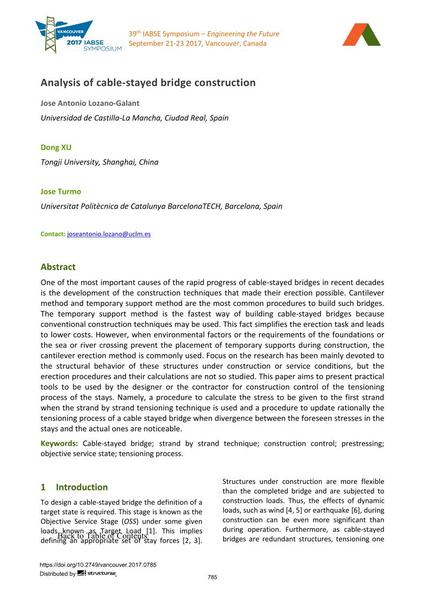Analysis of cable-stayed bridge construction

|
|
|||||||||||
Bibliografische Angaben
| Autor(en): |
Jose Antonio Lozano-Galant
Dong Xu (Tongji University, Shanghai, China) José Turmo |
||||
|---|---|---|---|---|---|
| Medium: | Tagungsbeitrag | ||||
| Sprache(n): | Englisch | ||||
| Tagung: | IABSE Symposium: Engineering the Future, Vancouver, Canada, 21-23 September 2017 | ||||
| Veröffentlicht in: | IABSE Symposium Vancouver 2017 | ||||
|
|||||
| Seite(n): | 785-792 | ||||
| Anzahl der Seiten (im PDF): | 8 | ||||
| Jahr: | 2017 | ||||
| DOI: | 10.2749/vancouver.2017.0785 | ||||
| Abstrakt: |
One of the most important causes of the rapid progress of cable-stayed bridges in recent decades is the development of the construction techniques that made their erection possible. Cantilever method and temporary support method are the most common procedures to build such bridges. The temporary support method is the fastest way of building cable-stayed bridges because conventional construction techniques may be used. This fact simplifies the erection task and leads to lower costs. However, when environmental factors or the requirements of the foundations or the sea or river crossing prevent the placement of temporary supports during construction, the cantilever erection method is commonly used. Focus on the research has been mainly devoted to the structural behavior of these structures under construction or service conditions, but the erection procedures and their calculations are not so studied. This paper aims to present practical tools to be used by the designer or the contractor for construction control of the tensioning process of the stays. Namely, a procedure to calculate the stress to be given to the first strand when the strand by strand tensioning technique is used and a procedure to update rationally the tensioning process of a cable stayed bridge when divergence between the foreseen stresses in the stays and the actual ones are noticeable. |
||||
| Stichwörter: |
Schrägseilbrücke Vorspannung
|
||||
